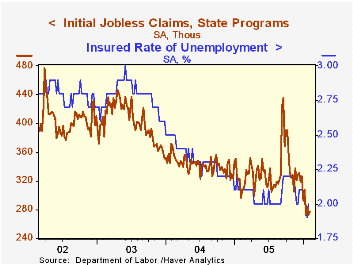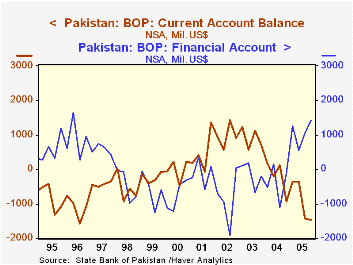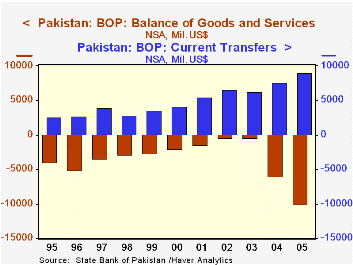 Global| Feb 09 2006
Global| Feb 09 2006Initial Claims for Unemployment Insurance Ticked Up
by:Tom Moeller
|in:Economy in Brief
Summary
Initial claims for jobless insurance ticked 4,000 higher last week to 277,000 following an unrevised 11,000 worker decline the prior week. Initial claims have been below 300,000 during five of the last six weeks. Consensus [...]

Initial claims for jobless insurance ticked 4,000 higher last week to 277,000 following an unrevised 11,000 worker decline the prior week. Initial claims have been below 300,000 during five of the last six weeks. Consensus expectations had been for an increase to 280,000 claims.
During the last ten years there has been a (negative) 75% correlation between the level of initial jobless insurance claims and the m/m change in payroll employment.
The four-week moving average of initial claims fell further to 276,500 (-12.6% y/y), the lowest level since April 2000.
Continuing unemployment insurance claims reversed most of the prior week's revised decline and rose 60,000.
The insured rate of unemployment rose back to 2.0% following the prior week's decline to 1.9%.
The January 2006 Senior Loan Officer Opinion Survey on Bank Lending Practices from the Federal Reserve Board is available here.
| Unemployment Insurance (000s) | 02/04/06 | 01/28/06 | Y/Y | 2005 | 2004 | 2003 |
|---|---|---|---|---|---|---|
| Initial Claims | 277 | 273 | -6.4% | 332 | 343 | 402 |
| Continuing Claims | -- | 2,557 | -5.7% | 2,663 | 2,924 | 3,532 |
by Carol Stone February 9, 2006

What happens to your balance of payments when there's an earthquake in your country? Your imports rise sharply, but funds will also flow into your country by way of aid and remittances. Pakistan's balance of payments for Q4, reported today by the State Bank of Pakistan, shows these phenomena. It also shows a striking increase in foreign direct investment, a very positive development for a country like Pakistan, hinting that some recovery from the earthquake can take place entirely independently of that earthquake-related aid.
The current account balance fell deeper into negative territory in Q4, reaching a deficit of $1.48 billion, encompassing a trade deficit that exceeded $2 billion. Q3 and Q4 together were far larger for both trade and current accounts than any other period in the 30-year history of these accounts. Imports were up 8.3% on the quarter (seasonally adjusted by Haver Analytics), pushed, according to the central bank's quarterly report, by imports of food, but eased by lower petroleum prices. In addition, the service deficit widened, in Q4 surpassing $1 billion for the first time (see table below). The bank suggests this account will remain in deficit due to construction services from companies that will work on the rebuilding effort. The deficit on income also increased slightly in Q4.
Offsetting these outflows of currency is a substantial quantity of worker and other remittances from abroad. In Q4, spurred partly by a response to the earthquake devastation, these current remittances surged to $2.5 billion and brought the year's total to nearly $9 billion, countering three-quarters of the total deficit in goods, services and income.
Also helping to limit the impact the current account on the financial condition of the country were positive flows in the financial account. Frequently, the financial side of nations' "balance" of payments is seen as a derivative of the current account; it consists, in the view of many, in the loans and trade credit that merely finance the current account. So a surplus in the financial accounts may be no more than a balancing item. But for Pakistan last year, there were some genuinely beneficial autonomous capital flows, direct investments in telecommunications and other industries. In Q4, these were $770 million, more than double the amount in Q3. For the year, direct investment totaled $2.2 billion, nearly double the amount in 2004. The financial account as a whole had a surplus of $4.3 billion, a dramatic turnaround from its deficit of $1.6 billion in 2004.
Thus, while Pakistan faces the burden of rebuilding after the earthquake that adds to its already existing development needs, the growth of global business appears to be making a significant contribution toward improving the economy of the nation.
| Pakistan (NSA, Bil.US$) | Q4 2005 | Q3 2005 | Q4 2004 | 2005 | 2004 | 2003 |
|---|---|---|---|---|---|---|
| Current Account Balance | -1.48 | -1.43 | -0.92 | -3.63 | -0.82 | +3.62 |
| Trade Balance | -2.06 | -1.90 | -1.49 | -6.21 | -3.39 | -0.20 |
| Services | -1.14 | -0.84 | -0.86 | -3.86 | -2.58 | -0.31 |
| Income | -0.76 | -0.58 | -0.69 | -2.52 | -2.37 | -2.22 |
| Current Transfers | +2.49 | +1.90 | +2.12 | +8.96 | +7.52 | +6.22 |
| Financial Account Balance | +1.42 | +1.06 | -0.12 | +4.29 | -1.61 | -0.58 |
| Direct Investment in Pakistan | +0.77 | +0.33 | +0.26 | +2.18 | +1.12 | +0.53 |
Tom Moeller
AuthorMore in Author Profile »Prior to joining Haver Analytics in 2000, Mr. Moeller worked as the Economist at Chancellor Capital Management from 1985 to 1999. There, he developed comprehensive economic forecasts and interpreted economic data for equity and fixed income portfolio managers. Also at Chancellor, Mr. Moeller worked as an equity analyst and was responsible for researching and rating companies in the economically sensitive automobile and housing industries for investment in Chancellor’s equity portfolio. Prior to joining Chancellor, Mr. Moeller was an Economist at Citibank from 1979 to 1984. He also analyzed pricing behavior in the metals industry for the Council on Wage and Price Stability in Washington, D.C. In 1999, Mr. Moeller received the award for most accurate forecast from the Forecasters' Club of New York. From 1990 to 1992 he was President of the New York Association for Business Economists. Mr. Moeller earned an M.B.A. in Finance from Fordham University, where he graduated in 1987. He holds a Bachelor of Arts in Economics from George Washington University.






